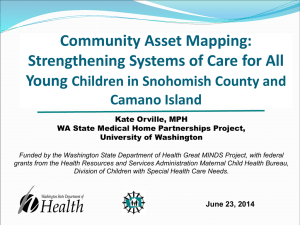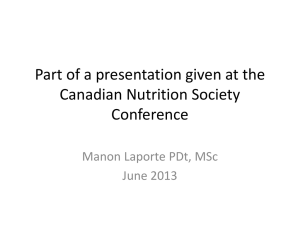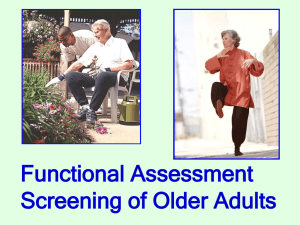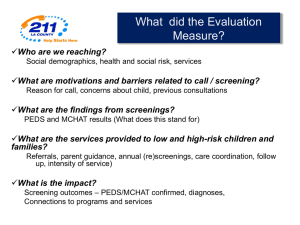12-10-14%20Developmental%20and%20Autism%20screening
advertisement
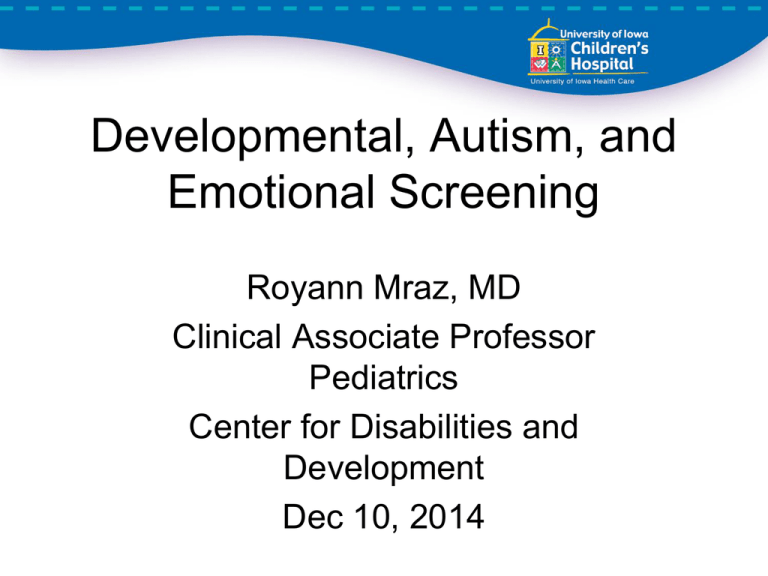
Developmental, Autism, and Emotional Screening Royann Mraz, MD Clinical Associate Professor Pediatrics Center for Disabilities and Development Dec 10, 2014 • No conflicts of interest to disclose Goals • Review developmental, autism, and social emotional screening Why screen ? • 16-20% of children have a developmental or behavioral disorder • 7-8% of children under 3 have delays • Clinical judgment may only detect 30% • Physician may be the only professional in contact with young child and family • Increases identification and referral Benefits of early intervention • Children with delays or environmental risk benefit from early childhood programs • Less grade retention, less need for special education services, lower dropout rate, improved health, improved income • Early Childhood programs save money – $30,000-100,000 per child DEVELOPMENTAL SURVEILLANCE • Identify risk factors—medical and psychosocial • Elicit parental concerns • Review milestones • Skilled observation over time • Selected screening • Anticipatory guidance, monitoring and/or referral EARLY DEVELOPMENTAL MILESTONES TYPICAL AGE DELAYED Social smile 2 months 3 months Babbling 6-10 months 10-12 months Sitting 6-8 months 9 months Early Pincer grasp 8-10 months 12 months Single words 11-15 months 18 months Walking 11-15 months 18 months LANGUAGE MILESTONES • • • • • Cooing – 2-3 months Babbling – 6-10 months Understands “No” – 9-10 months “Mama” “Dada” – 10-12 months 1 step command without gesture – 12-14 months • 3-10+ words – 18 months • Combines 2 words – 21-24 months LANGUAGE MILESTONES • 50 Word vocabulary – 24 months • Pronouns – 2 years old • Average length of utterance one word for each year of age from 2-4 years old • Percentage of speech intelligible – 50% by 2 years, 75% by 3 years, 100% by 4 years 30 month old girl • • • • • • Speech delay 15-20 words, can’t follow simple directions Normal pregnancy and delivery No major illnesses What other history would you like? Differential diagnoses? Speech delay- most common delay • • • • • • Speech/language disorder Mild intellectual disability Transient speech delay, Autism spectrum disorder Hearing impairment Environment Developmental Screening overview • AAP recommends surveillance at every well child visit • AAP recommends formal screening at 9, 18, and 30 months and whenever there is a concern • Serial surveillance and screening is the most effective • Screening may be recommended at 3 & 4 years Trends in Use of Developmental Screening 2002-2009 • 2002- less than 25% of AAP fellows used formal developmental screening • 2009 – 47% used one of more screening tools • Most commonly used tools were ASQ, PEDS, and M-CHAT Developmental Screening -2007 • Iowa- 19% of children receive formal developmental screening • Pennsylvania -11%, North Carolina -47% • Increased screening for younger, minority, and publicly insured children • Based on National Survey of Children’s Health 2007 • Higher rates of Early Intervention with higher screening. Developmental Screening • Screening is not diagnostic or predictive • Screening aims to identify those children who need further evaluation • If child is delayed in one area, check development in all areas • Screen development in children with behavior problems Developmental Screening – parent completed questionnaires • Involves the parents • Stimulus for questions • Educates parents about normal development • Time efficient for healthcare provider • Sensitivity and specificity are as good as most administered screening tools Developmental Screening • Sensitivity - % of children with delays identified with the screener • Specificity - % of typical children identified as typical or low risk • 70-80% sensitivity and specificity is considered acceptable Developmental Questionnaires • Ages and Stages Questionnaires-3, 2-60 months, (Bricker and Squires) 2009 (endorsed by IDPH, CHSC,DHS) • Parents’ Evaluation of Developmental Status (PEDS) – 0-8 years, parental concerns, (Glascoe)- (prescreener) • Parents’ Evaluation of Developmental Status: Developmental Milestones (PEDS-DM) – 0-8 years, (Glascoe) • Child Development Inventories, 3-72 months, (Ireton)- (Infant scale is very good) Ages and Stages-3, 2009 • • • • • 2-60 months Sensitivity 86% Specificity 85% 25-35 items 10-20 min. for parent, 2-3 min. to score • 21 forms, specific for child’s age Ages and Stages-3 • Communication, FM,GM, problemsolving, personalsocial • Identifies strengths and weaknesses • Forms can be copied • On-line options Ages and Stages-3 • Separate scores for Communication, GM, FM, Problem-solving, Personal-Social • Yes=10, Sometimes=5, Not yet=0 • Total scores recorded on chart • Above the cutoff –on schedule (>-1SD) • Close to the cutoff – monitor (-2 to -1SD) • Below the cutoff – needs assessment (below -2 SD) PEDS • 10 Questions, also in Spanish and online • 5th grade reading level • Elicits parent concern about development and behavior • Same form for all ages, brief • Sensitivity 74-79%, Specificity 70-80% PEDS • Glascoe recommends evaluation if 2 or more significant concerns (11%) • Screen if 1 concern (26%) • Need second level screener Developmental Screening • Parent completed questionnaires make sense • Remember to Refer – 50-80% of children with at risk screens are not referred • If child doesn’t qualify for Early Intervention, consider Headstart, speech therapy, etc. Autistic Spectrum Disorders • 1/68 children have autistic spectrum disorder • Group of neurodevelopmental disorders • Early intervention improves outcome DSM-5 Criteria for ASD • Deficits in social communication and social interactions Social emotional reciprocity Nonverbal communication Relationships • Restricted, repetitive patterns of behavior, interests, or activities • Present in early childhood • Limit and impair functioning Joint Attention • More specific to autism than speech delay • Coordinate attention between an object and a person in a social context – responding to point or initiating point • 8 mo Gaze monitoring • 10 mo Follow a point • 12 mo Point to request • 14 mo Point to show Autism Screening • ASD is common • Why screen? Better outcome with early intervention • First step- routine developmental surveillance/screening • AAP recommends use of autism specific questionnaire at 18 and 24 mo • Vigilance in siblings Red Flags • No back and forth sharing of sounds, smiles, and other facial expressions by 9 months • No babbling, pointing or other gestures by 12 months • No single words by 16 months • No spontaneous two word phrases by 24 months • Any loss of language or social skills at any time Filipek, PA, Practice Parameter: Screening and Diagnosis of autism. Neurology 2000;55:468-479 Autism Specific Questionnaires • M-CHAT Modified Checklist for Autism in Toddlers 18-30 months -Parent questionnaire, Sens 85-87%, Spec 93% - revised version 2012 • Pervasive Dev Disorders Screening Test PDDST-II – Stage I 12-24 months, Sensitivity and specificity are moderate to high • CSBS Infant and Toddler Checklist- 6-24 mo, available in AAP Autism toolkit. Sens 76-88%, spec 82-87%, also identifies children with dd and speech disorders • Social Communication Questionnaire - 4 years+, Sens 85%, Spec 75% Modified Checklist for Autism in Toddlers Please fill out the following about how your child usually is. Please try to answer every question. If the behavior is rare (e.g., you've seen it once or twice), please answer as if the child does not do it. 1. 2. 3. 4. 5. Does your child enjoy being swung, bounced on your knee, etc.? Does your child take an interest in other children? Does your child like climbing on things, such as up stairs? Does your child enjoy playing peek-a-boo/hide-and-seek? Does your child ever pretend, for example, to talk on the phone or take care of dolls, or pretend other things? 6. Does your child ever use his/her index finger to point, to ask for something? 7. Does your child ever use his/her index finger to point, to indicate interest in something? 8. Can your child play properly with small toys (e.g. cars or bricks) without just mouthing, fiddling, or dropping them? 9. Does your child ever bring objects over to you (parent) to show you something? 10. Does your child look you in the eye for more than a second or two? 11. Does your child ever seem oversensitive to noise? (e.g., plugging ears) 12. Does your child smile in response to your face or your smile? 13. Does your child imitate you? (e.g., you make a face-will your child imitate it?) 14. Does your child respond to his/her name when you call? 15. If you point at a toy across the room, does your child look at it? 16. Does your child walk? 17. Does your child look at things you are looking at? 18. Does your child make unusual finger movements near his/her face? 19. Does your child try to attract your attention to his/her own activity? 20. Have you ever wondered if your child is deaf? 21. Does your child understand what people say? 22. Does your child sometimes stare at nothing or wander with no purpose? 23. Does your child look at your face to check your reaction when faced with something unfamiliar? 1999 Diana Robins, Deborah Fein, & Marianne Barton M-CHAT-R/F • • • • • Revised edition M-CHAT- R/F – Simplified language and scoring, Aim to decrease false positives, Low, moderate, or high risk If in moderate risk, Follow-up questions for any failed item • M-chat.org Possible Autism • Refer to Early Access for evaluation, therapy and other services, Preschool at age 3,consult Regional autism centers • Consider additional therapy- behavioral, speech • Refer for diagnostic evaluation – assessment of cognitive and adaptive skills, receptive and expressive language, hearing, medical (Consider genetic testing) • Parent support and information Mental health screening in Pediatrics • 20% of children and adolescents have a mental health diagnosis • Services need to be available • Best evidence for benefit is for depression screening in teens Behavioral-Emotional Screening • Brief broadband screeners ASQ-SE, Pediatric symptom checklist • Indepth broadband screeners – Child Behavior checklist, others • Narrow band – Vanderbilt, others AAP Task Force on Mental Health 2009 • Use validated social-emotional screening for children 0-5 yr if risk factors, such as Abnormal development screen, poor growth, Poor attachment, Excessive crying, clinging, fearfulness Regression Family psychosocial concerns • Ages and Stages –Social Emotional 6-60 mo. Older child and teen • AAP - Use of validated screen for mental illness at all well visits -5 years and up & • Times of family disruption, poor school performance, behavioral problems, recurrent somatic complaints, involvement of DHS or juvenile justice, and reported family psychosocial concerns • Pediatrics. June 2010 Supplement Behavioral/Emotional Screening – older child – initial screening • Pediatric Symptom Checklist (Jellinek) – 6-16 yrs, 35 items, <5 min., Sens 80-95%, Spec. 68%-100%, internalizing, externalizing, and attention problems. www.dbped.org, free, can be used as young as 4 yrs Depression Screening • AAP/Bright Futures recommends screening yearly at age 11 and up • PHQ-2 Over the past 2 weeks, how often have you been bothered by any of these problems? • Little interest or pleasure in doing things? • Feeling down, depressed or hopeless? PHQ-2 • Several days (1), more than ½ (2), nearly every day (3) • Teens with scores of 3 or more should be evaluated for possible depression Substance Abuse Screening • AAP/Bright Futures recommends assessing all youth 11 years and up for alcohol, tobacco, or drug use • AAP/Bright Futures recommends asking about experimentation/use • Specific questionnaires to assess problem use, such as the CRAFFT Substance Use Screening • • • • • • CRAFFT is a commonly used tool Part A During the past 12 months, did you: Drink any alcohol (more than sip)? Smoke marijuana? Use anything to get high? CRAFFT • If not to all questions in part A, ask CAR question only. If yes in any in part A, ask all • Have you ridden in a CAR driven by someone high or using alcohol or drugs? • Do you ever use to RELAX? • Do you ever use ALONE? • Do you ever FORGET while using? • Do your FAMILY or FRIENDS tell you to cut down? • Have you gotten into TROUBLE while using? Summary • Listen to parents’ concerns • Developmental and autism screening • Screen for teen depression and substance use • Social emotional screening • Learn community resources • Refer early Education -Early Intervention Birth to Three In home services in Iowa, teacher, OT, PT, ST, SW 1-888-IAKIDS1 www.earlyaccessiowa. org –good list of resources in IA Resources • www.dbpeds.org Dev Behav Peds website, articles and handouts • www.pedstest.com PEDS, links • www.firstsigns.org Development and autism screening • www.brookespublishing.com Ages&Stages Resources • www.brightfutures.aap.org Guidelines for Health Supervision Third Edition 2007 • AAP Medical Home website • Developmental-Behavioral Pediatrics (DBP): www.phoenixchildrens.com\dbpeds • Developmental Screening Toolbox Boston Children’s Hospital www.developmentalscreening.org ASD Resources • • • • • www.firstsigns.org videos, M-CHAT www.autismspeaks.org videos www.cdc.gov/actearly M-CHAT Information AAP Autism Toolkit, including handouts for families • AAP Understanding Autism Spectrum Disorders brochure for families References • AAP Policy Statement Identifying Infants and Young Children with Developmental disorders in the medical home Pediatrics: 118:405-420, 2006. • LaRosa, A. Developmental and behavioral screening. 2014Up-To-Date, accessed 7.22.2014 • Kelly, N. Screening tests in Children and Adolescents. Up-to-Date, accessed 7.22.2014 • Garg, A. Applying Surveillance and Screening to Family Psychosocial Issues. JDBP: 32:418-426, 2011 References • Robins, DL, Casagrande, K, Barton, M. Validation of the M-CHAT-R/F. Pediatrics. 2014;133:37-45. • Marks, KP, LaRosa, AC. Understanding Developmental-Behavioral Screening Measures. Pediatrics in Review.2012;448458.

